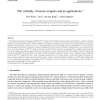Free Online Productivity Tools
i2Speak
i2Symbol
i2OCR
iTex2Img
iWeb2Print
iWeb2Shot
i2Type
iPdf2Split
iPdf2Merge
i2Bopomofo
i2Arabic
i2Style
i2Image
i2PDF
iLatex2Rtf
Sci2ools
COMPGEOM
2005
ACM
2005
ACM
The Visibility-Voronoi Complex and Its Applications
We introduce a new type of diagram called the VV(c)-diagram (the visibility–Voronoi diagram for clearance c), which is a hybrid between the visibility graph and the Voronoi diagram of polygons in the plane. It evolves from the visibility graph to the Voronoi diagram as the parameter c grows from 0 to ∞. This diagram can be used for planning natural-looking paths for a robot translating amidst polygonal obstacles in the plane. A natural-looking path is short, smooth, and keeps—where possible—an amount of clearance c from the obstacles. The VV(c)-diagram contains such paths. We also propose an algorithm that is capable of preprocessing a scene of configuration-space polygonal obstacles and constructs a data structure called the VV-complex. The VV-complex can be used to efficiently plan motion paths for any start and goal configuration and any clearance value c, without having to explicitly construct the VV(c)-diagram for that c-value. The preprocessing time is O(n2 logn), whe...
| Added | 13 Oct 2010 |
| Updated | 13 Oct 2010 |
| Type | Conference |
| Year | 2005 |
| Where | COMPGEOM |
| Authors | Ron Wein, Jur P. van den Berg, Dan Halperin |
Comments (0)

